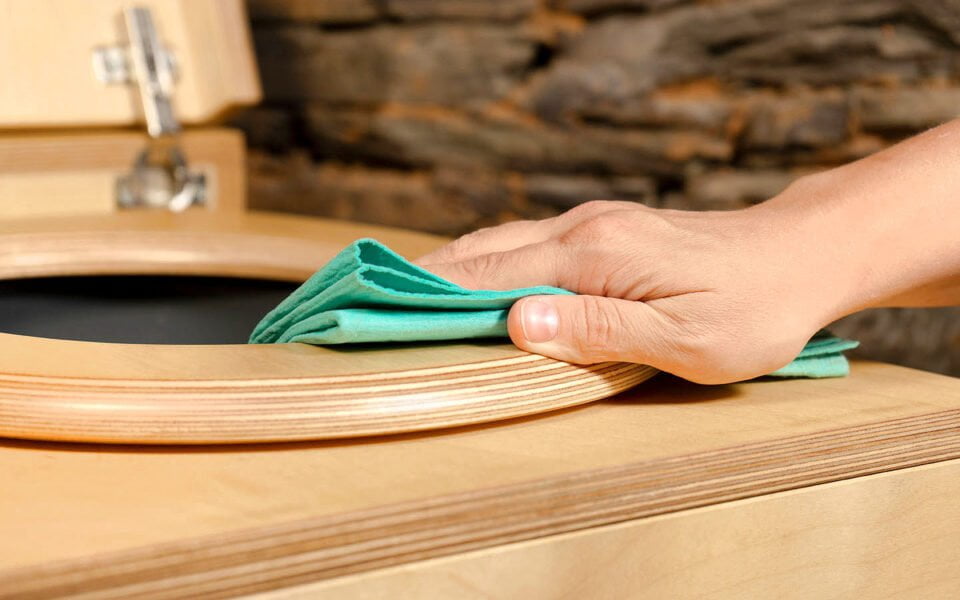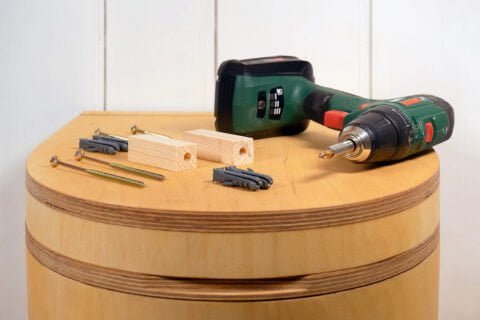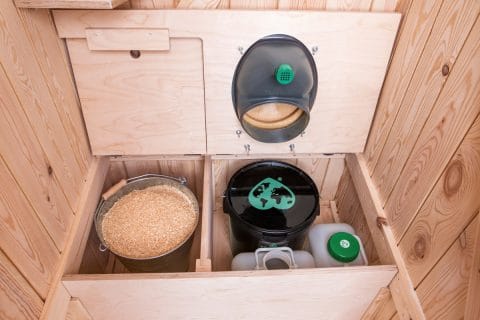TROBOLO SilvaBlœm
Shapely composting toilet made of wood with HPL finish and optional exhaust system.

Especially on vacation, while traveling or basically on the road, time can certainly be better passed than emptying a composting toilet, not to mention cleaning and disposing the composting toilet waste. Fortunately, this is child's play with a TROBOLO. Find out what is important in the process here.
One thing in advance: TROBOLO camping toilets can be cleaned at least as easily and hygienically as conventional toilets.
Compared to chemical toilets, composting toilets save you the time-consuming task of emptying and cleaning at often expensive disposal stations.
All excretions only come into contact with the plastic surfaces.
Even if the user suffers from diarrhea, everything goes directly into the solids container.
Thanks to the replaceable inlay, the solids container remains clean and the cleaning effort is therefore minimal.

Our pre-treated wooden surfaces can be cleaned with a damp cloth. Just like the toilet seat with antibacterial protective coating.
A unoiled surface should be coated with a natural oil, for example, to ensure resistance to moisture as well.
You can choose between an oiled or unoiled surface finish while ordering a TROBOLO toilet.
With our composting toilets made of recyclable polypropylene, such as the TROBOLO WandaGO, no special care or impregnation is required as with the TROBOLO wooden models.
Instead, they can be cleaned from top to bottom completely with biological cleaning agents.
When cleaning the partition insert, you should avoid aggressive cleaning agents with abrasive content. This is because it is made of hard-wearing plastic and has a surface seal. However, this seal would be damaged by scrubbing.
Power cleaners, chlorine cleaners, alkaline or acidic cleaners or cleaners containing solvents can attack the material and make it porous. As a result, it loses its longevity.
Here you can take a look at what you need to know about how to clean a composting toilet:

After you have emptied the composting toilet, the solid waste container is fitted with a new inlay, which is inserted into the container like a bag.
This simplifies the disposal of the composting toilet. If necessary, you can also wipe out the empty solids container with some kitchen paper.
The liquid container can be rinsed with a little water and detergent if necessary and otherwise does not require extensive cleaning.
From time to time, you can also clean the bowl and separator insert with diluted lemon water or vinegar essence to counteract urine scale and limescale deposits.
Now that we have clarified how to empty, clean and dispose waste of a composting toilet, we want to know: Is such a composting toilet really hygienic?
The answer is clearly yes.
You will quickly notice that using a TROBOLO works just like using a conventional toilet. Body contact occurs only at the toilet seat.
When you want to empty the composting toilet, you can remove the two separate containers in a few easy steps. Without coming into contact with the waste.
So, you don’t have to compromise on hygiene when using a TROBOLO. Nor do you have to forego the usual comfort of your home toilet.
There is also no need to worry about odor.
Normally, fresh urine does not smell. Only certain foods, such as asparagus, alcohol or onions and garlic, and the combination with water have an effect on the smell.
The unpleasant ammonia odor that is so feared only develops during prolonged storage. This is because the decomposition of the urine by bacteria is then already more advanced.
To avoid odors from the urine container in the first place, we recommend that you empty it every 2-3 days.
Through the litter or also the exhaust air system, the moisture in the solids is bound or dried. This also prevents the formation of unpleasant odors.
Sign up for our newsletter here to never miss out on any news or free promotions.

"Do-it-yourself" is the latest trend, so it's not surprising that more and more people want to build their composting toilet themselves. But how does that actually work? In this article, we take a closer look at the topic and give you numerous tips and tricks to make your do-it-yourself project a success. Have fun!
Read more
Below you will find information on functionality, areas of application as well as advantages and disadvantages of separating and dry toilets.
Read more
In this guide, you will find information about the functionality, areas of application as well as the benefits and disadvantages of chemical toilets.
Read more¡Tenemos buenas noticias! Aunque gran parte de nuestro contenido todavía esté en inglés, ya hacemos envíos a tu país. Solo tienes que hacer el pedido y los productos te llegarán directamente a casa.
De acuerdoBuone notizie! Anche se la maggior parte dei nostri contenuti è ancora in inglese, spediamo già nel tuo paese. Fai un ordine e ricevi i prodotti direttamente a casa tua.
D'accordoVi har gode nyheder! Selvom det meste af vores indhold stadig er på engelsk, sender vi nu til dit land. Du skal bare afgive din ordre, så bliver produkterne leveret direkte hjem til dig.
ForståetWe hebben goed nieuws! Hoewel het meeste van onze inhoud nog steeds in het Engels is, verzenden we nu naar uw land. Plaats uw bestelling en de producten worden direct bij u thuisbezorgd.
BegrepenYou are currently viewing a placeholder content from Facebook. To access the actual content, click the button below. Please note that doing so will share data with third-party providers.
More Information